Pioneer Coveralls
Pioneer Coveralls: Complete Industrial Protection Guide
Have you ever watched a coworker receive second-degree burns because their coverall wasn't actually rated for the chemicals they handled? Or discovered mid-shift that your "protective" workwear was protecting nothing? You're looking at one-piece protective workwear that shields your entire body—torso, arms, and legs—from the specific hazards in your work environment. Whether you handle petroleum products daily, face welding sparks, or work with industrial chemicals, understanding Pioneer coverall construction and specifications helps you choose protection that actually works for your application—not just protection that sounds good in a product description.
What Makes Industrial Pioneer Coveralls Effective Protection
Here's what most safety managers miss: A coverall is a single-piece garment, meaning there's no gap between jacket and pants where contaminants can reach your skin or underlying clothing. This continuous barrier matters most when you're working overhead (preventing drips down your back) or kneeling in contaminated areas (preventing exposure at your waistline). That seemingly minor detail has prevented countless chemical burns and contamination injuries.
The construction typically includes:
- Base fabric weight: 7-9 oz/yd² cotton blend for general use, 12-14 oz/yd² for heavy-duty applications, or specialized synthetic materials rated for specific chemical families
- Reinforcement zones: Double-layer fabric at knees and elbows (high-contact areas), triple-stitched seams at stress points (crotch, underarms), and bartack reinforcement at pocket corners
- Closure systems: Front zippers (typically brass YKK #5 for durability), two-way zippers for bathroom access, storm flaps over zippers to prevent contamination infiltration, and snap closures at collar and waist
- Pocket engineering: Chest pockets sized for 4"×6" notebooks, side pockets with 8" depth, ruler pockets on legs (typically 12"×1.5"), and tool loops rated for 2 lb loads
How Different Workers Use Pioneer Coveralls
Consider how automotive technicians approach fluid service: they put on coveralls before sliding under vehicles because a single drop of 200°F transmission fluid on skin causes second-degree burns. The coverall's oil-resistant finish (typically fluoropolymer treatment) causes petroleum products to bead rather than soak through to skin contact.
In chemical processing, operators wear coveralls rated against specific substance families. For example, chlorinated solvents require butyl rubber coatings, while organic acids need neoprene treatments. The wrong material selection provides zero protection—hydrochloric acid penetrates standard cotton in under 30 seconds.
Welders face different physics: molten metal at 2,500°F lands on fabric. Treated aramid fibers (like Kevlar or Nomex) char but don't ignite, while untreated cotton bursts into flame. The difference between FR-rated and non-FR coveralls is literally burn-ward hospitalization versus walking away with minor discomfort.
Matching Coveralls to Your Specific Hazards
Chemical Exposure Environments
Start by listing every chemical you handle—not categories, but specific compounds. ASTM F903 permeation testing measures breakthrough time (how long until the chemical reaches your skin) for individual substances against specific fabric types.
| Petroleum distillates (gasoline, diesel, kerosene) | Treated cotton/poly blend, 8 oz minimum |
| Organic acids (acetic, formic) | Neoprene-coated fabric, >4-hour breakthrough |
| Inorganic acids (sulfuric, hydrochloric) | Butyl rubber coating, >6-hour breakthrough |
| Solvents (acetone, MEK, toluene) | Viton or Teflon-coated materials |
| Caustics (sodium hydroxide, potassium hydroxide) | PVC-coated polyester |
Critical specification: Request the manufacturer's permeation test data for YOUR specific chemicals. Generic "chemical resistant" claims are meaningless—you need documented breakthrough times for the actual substances in your facility.
Thermal and Flame Hazards
NFPA 2112 certification means the fabric passed specific tests: a three-second propane torch exposure must self-extinguish in under two seconds, with less than 4 inches of char length. This matters during flash fire events when you have roughly 1.5 seconds of exposure before receiving third-degree burns through non-FR clothing.
The testing also measures after-flame (continued burning after ignition source removal) and heat transfer (how much thermal energy penetrates to skin). Look for these specific performance metrics:
- Arc rating (ATPV): Measured in cal/cm². Electricians need minimum 8 cal/cm² for general work, 25+ cal/cm² for high-energy tasks. Your facility's arc flash study determines the required level.
- Heat resistance: Welding coveralls should withstand 500°F radiant heat without degradation. Foundry work requires 800°F+ tolerance.
- Thermal protective performance (TPP): Minimum 10 for industrial fire protection, 35+ for firefighting applications.
Understand that FR treatments degrade: after 50-75 industrial wash cycles, protection decreases measurably. Replace FR coveralls annually with daily use, or maintain wash count logs to track protection degradation.
Mechanical and Abrasion Environments
If your primary concern is durability rather than chemical or thermal protection, focus on fabric weight and construction quality. A mechanic doing brake jobs doesn't need FR rating or chemical barriers—they need fabric that survives 200+ wash cycles while resisting tears from sharp metal edges.
Specifications to verify:
- Tensile strength: Minimum 100 lbf for warp and fill directions (ASTM D5034 test)
- Tear resistance: 40+ lbf using trapezoidal tear test (ASTM D4533)
- Seam strength: 90% of fabric strength minimum—weak seams fail first
- Abrasion cycles: 10,000+ cycles on Martindale abrasion tester for knee/elbow reinforcements
Sizing for Safety and Comfort
Incorrectly sized coveralls create hazards: too tight restricts your movement (try climbing a ladder in coveralls that bind your shoulders), too loose creates snag points around rotating equipment.
Measure yourself wearing your typical work clothing layers:
- Chest: Measure around fullest part, arms at sides. Add 4-6 inches to this measurement for your coverall chest size (the extra room allows arm movement without binding)
- Waist: Measure at natural waistline (typically at navel level). Add 2-4 inches—you're wearing a belt underneath
- Inseam: Measure from crotch to floor. Subtract 1 inch (coveralls ride slightly higher than pants due to torso attachment)
- Sleeve length: From center back neck, across shoulder, down arm to wrist with arm slightly bent. Proper sleeve length means the cuff sits at wrist bone when arms are extended
Between sizes? Choose the larger size. You can cinch excess fabric with a belt, but you cannot add mobility to too-small coveralls.
Special Fit Considerations
Tall/short variants: If you're 6'2"+ or under 5'6", standard sizing rarely works. Look for manufacturers offering tall (adds 2" to sleeves and inseam) or short (removes 2") modifications without upcharges.
Action backs: This is a fabric expansion pleat between shoulder blades that allows you to reach forward and overhead without the coverall pulling tight across your back. Essential for mechanics, electricians, and anyone working above shoulder height frequently. Check if this feature is standard or requires upgrade.
Elastic waistbands: Some coveralls include 2-4 inches of elastic panel at sides. This allows the same coverall to fit workers whose weight fluctuates seasonally (common in construction and agriculture). Trade-off: slightly less professional appearance than fitted waists.
Practical Features That Actually Matter
Pocket Configuration Reality
Marketing materials show coveralls with 12+ pockets. In practice, you'll use 3-4 regularly. What matters is whether those 3-4 pockets match your actual tools and access patterns.
Chest pockets: Typical 7"×5" size holds smartphone, small notebooks, or pen sets. Flap closures (button or hook-and-loop) prevent items falling out when you bend over. Pencil slots inside pockets keep pens accessible but secured.
Side hand pockets: You'll instinctively reach for these constantly. Minimum 8" depth prevents your phone or multitool from falling out when you sit or crouch. Angled openings (15-20° from vertical) make access easier than straight-cut pockets. Internal key clips attach to belt loops inside.
Leg pockets: Cargo-style thigh pockets hold larger items (6"×8" typical). These work well for tape measures, gloves, or safety glasses cases. Reality check: if you crouch or kneel frequently, items in leg pockets dig into your thighs. Bottom leg pockets (below knee) eliminate this issue but require you to stand to access contents.
Ruler pockets: Narrow vertical pockets on thigh, typically 12"×1.5", designed for folding rulers or levels. Useful feature if you actually carry these tools daily; otherwise, it's wasted stitching that can snag.
Closure Systems: The Engineering Matters
Zippers fail most often on coveralls. Quality indicators:
- YKK brand #5 brass zippers: Industry standard for durability. #5 refers to tooth width (5mm)—larger than clothing zippers (#3) but not so large they're stiff
- Two-way zippers: Open from both top and bottom. Critical for bathroom access without complete removal—unzip from bottom 8-10 inches
- Storm flaps: Fabric panel covering the zipper from inside or outside. Inside flaps (more common) prevent contaminants infiltrating through zipper teeth. Outside flaps provide additional impact protection for the zipper
- Zipper pulls: Oversized pulls (2" minimum) work with gloved hands. Some have glow-in-dark coating for visibility in low-light
Alternative closures: Snap-front coveralls use 7-10 heavy-duty snaps instead of zippers. Advantages: no zipper to break, faster donning/doffing. Disadvantages: less secure closure (gaps between snaps), no storm flap protection possible. Use these for light-duty or disposable applications, not for serious contamination control.
Visibility Features for Worksite Safety
CSA Z96 Class 2 Level 2 rating (similar to ANSI/ISEA 107-2020 Class 2) requires specific measurements of high-visibility material:
- Background material (fluorescent yellow-green or orange-red): minimum 775 in² for Class 2
- Retroreflective tape: minimum 201 in² arranged in horizontal bands (around chest/waist) and vertical shoulder straps
- Combined performance specification: minimum 1,240 in² total high-visibility material
This matters in specific situations: roadway work zones, areas with mobile equipment, low-light conditions (dawn/dusk/night), and sites where workers might not be expecting your presence (delivery access, loading docks).
The standard doesn't require high-visibility coveralls everywhere—in fact, they're inappropriate for welding (bright colors reflect more arc radiation into your eyes) and around some rotating equipment (highly visible clothing can be more distracting than safety-enhancing). Use visibility features where regulations or site safety programs specifically require them.
Real-World Industry Applications
Automotive Service Centers
Brake fluid (DOT 3, DOT 4, DOT 5.1) dissolves paint and damages skin on contact. Automatic transmission fluid operates at 180-220°F and causes immediate burns. Coolant contains ethylene glycol—toxic if absorbed through skin in sufficient quantity over time.
What works: 8-9 oz cotton/polyester blend (typically 65/35 ratio) with oil-resistant treatment. The synthetic content (polyester) provides durability and faster drying after washing; cotton provides comfort and breathability during physical work. Price range: $45-75 per garment for quality construction.
What technicians actually need: chest pockets for phone and work order clipboard, reinforced knees (you're kneeling 40-60 times per day during tire service and brake jobs), and side pockets deep enough that your trim panel tools don't fall out when you crouch into vehicle interiors. Elastic waist panels accommodate the reality that technicians' weight fluctuates 10-15 lbs seasonally.
Welding and Metal Fabrication
Arc welding at 150 amps produces UV radiation equivalent to looking at the sun—your clothing must block this radiation to prevent sunburn-like skin damage through fabric. Spatter (molten metal droplets) ranges from 1,800°F (aluminum) to 2,800°F (steel). Slag removal generates sharp fragments traveling at speeds that puncture non-protective fabric.
What works: NFPA 2112 compliant FR cotton (9-10 oz minimum) or FR cotton/nylon blend. Aramid fiber coveralls (Nomex, Kevlar blends) provide superior protection but cost $180-280 per garment. For production welding (6-8 hours daily), this investment pays off in durability—aramid coveralls last 18-24 months versus 8-12 months for FR cotton.
Design specifics welders need: velcro closures at collar and cuffs (traditional buttons melt when spatter lands on them), no exposed metal like zippers on shoulders where overhead welding drops spatter, and pockets positioned on sides rather than chest (chest pockets catch and hold hot spatter against your body). Leather reinforcement panels on chest, shoulders, and forearms provide additional protection during heavy spatter operations.
Chemical Processing and Industrial Manufacturing
Facility safety managers typically designate specific coverall requirements based on process safety analysis. For example, a plant manufacturing agricultural chemicals might specify: "Tyvek or equivalent disposable coveralls for mixing operations, reusable neoprene-coated coveralls for tank cleaning, and standard cotton blend for maintenance work in non-processing areas."
The critical concept: different areas require different protection levels. Spending $280 on high-end chemical suits for every worker in every area wastes money. Spending $35 on inadequate protection in the mixing room gets people hurt.
Mapping protection to actual exposure:
- Splash zone (within 3 feet of open chemical handling): Chemical-resistant coverall rated for specific substances present, with breakthrough time exceeding your longest typical task by 50%+ margin
- Transfer zone (moving chemicals between containers, 3-10 feet): Chemical-resistant or coated fabric with 2+ hour breakthrough for substances present
- Production floor (operating closed systems): Standard industrial coveralls providing barrier against incidental contact
- Maintenance/non-processing areas: Regular work clothing or light-duty coveralls if facility policy requires them
Construction and Heavy Civil Work
Concrete is alkaline—pH 12-13 when wet—and causes chemical burns through prolonged skin contact. Uncured epoxy causes sensitization (allergic reactions that worsen with repeated exposure). Paint overspray embeds in fabric and transfers to skin through friction.
What construction crews actually wear: disposable coveralls ($3-8 each) for spray painting and demolition work where the garment becomes too contaminated to clean effectively, plus one set of durable coveralls ($50-85) for concrete work, framing, and general construction. The disposable suits get discarded with the job site waste; the durable set goes through 1-2 wash cycles weekly.
High-visibility requirements: most highway and roadway projects mandate CSA Z96/ANSI Class 2 minimum. Many general contractors require the same on sites with active equipment traffic. Add $15-30 to coverall cost for visibility features. Some jurisdictions require Class 3 (even more visible material) for workers exposed to traffic exceeding 50 mph.
Standards, Certifications, and What They Actually Mean
Flame Resistance: NFPA 2112
This standard exists because workers kept dying in flash fires. A flash fire—sudden ignition of fuel vapor or dust cloud—produces 1,000°F+ temperatures for 3-5 seconds. Workers wearing cotton or synthetic blends received 30-80% body surface burns. Workers in FR-rated coveralls received minor to moderate burns (10-25% body surface) concentrated on exposed areas like hands and neck.
The NFPA 2112 test protocol: expose fabric to 84 kW/m² radiant heat (equivalent to 1-second propane torch application) and measure after-flame time, char length, and heat transfer. Passing requires: after-flame under 2 seconds, char length under 4 inches, no melt-drip, and no holes forming in fabric.
Real-world implication: FR coveralls give you time to escape the flash fire zone and execute stop-drop-roll procedures. They don't make you fireproof—you'll still get burned if you can't escape within 5-8 seconds. But you survive, whereas non-FR clothing means critical burns.
Chemical Protection: ASTM F903
This test measures permeation—the time from when a chemical contacts fabric surface until it appears on skin-side surface. The result is breakthrough time measured in minutes.
Why this matters: you're changing a valve on a process line. Chemical splashes on your coverall. How long until it penetrates to your skin? If breakthrough time is 30 minutes and your task requires 45 minutes, you're getting exposed. If breakthrough time is 120 minutes and you finish in 45, you're protected.
Understand the limitation: breakthrough times are measured at 72°F in lab conditions. Process chemicals at 150°F permeate faster. Movement and friction accelerate permeation. Always select coveralls with breakthrough times 2-3× longer than your expected maximum exposure duration.
High Visibility: CSA Z96 and ANSI/ISEA 107
Class 1: 155 in² background + 155 in² retroreflective = minimum visibility for low-risk environments, speeds under 25 mph
Class 2: 775 in² background + 201 in² retroreflective = standard for construction sites, roadwork, speeds under 50 mph
Class 3: 1,240 in² background + 310 in² retroreflective = high-risk environments, highway work, speeds exceeding 50 mph
The retroreflective tape must form specific patterns: 360° visibility (visible from all horizontal angles) with bands around torso and over shoulders. This geometry ensures drivers see workers regardless of body position.
Calculating True Cost: Purchase + Maintenance + Replacement
Example scenario: outfit 10 workers for automotive shop
| Initial purchase (3 coveralls/worker @ $60) | $1,800 |
| Annual laundering (156 wash cycles @ $4/cycle) | $624 |
| Replacement (10 coveralls annually @ $60) | $600 |
| Annual cost per worker | $302 |
Compare this to a chemical plant needing specialty coveralls:
| Initial purchase (2 chemical-resistant @ $180) | $360 |
| Specialized laundering (100 cycles @ $12) | $1,200 |
| Annual replacement (both coveralls) | $360 |
| Annual cost per worker | $1,920 |
The lesson: maintenance costs exceed purchase price for most coverall programs. When evaluating suppliers, ask about:
- Recommended wash frequency for your contamination levels
- Whether FR or chemical treatments degrade in standard commercial laundry
- Expected service life under your use conditions
- Bulk purchase pricing for ongoing replacement needs
Industrial Laundry Service vs. Home/Commercial Washing
Industrial laundry services (Cintas, Unifirst, Aramark, etc.) charge $3-15 per coverall depending on contamination level and protective treatment. They provide:
- Specialized detergents that remove petroleum and chemical residues without degrading FR treatments
- Inspection during processing—damaged garments flagged for replacement before they fail in use
- Documentation of wash cycles for tracking FR treatment degradation
- Weekly or twice-weekly pickup/delivery
Standard commercial washing works for light-duty coveralls without specialized treatments. Cost: $2-4 per wash cycle. Limitations: petroleum-based contaminants require pre-treatment, FR coveralls need pH-neutral detergents, and you're responsible for inspection and replacement tracking.
Maintenance Procedures That Preserve Protection
Daily Inspection Before Donning
Spend 30 seconds checking these failure points:
- Zipper track: Run zipper up and down full length. Catch or skip = zipper failure imminent. Replace before it fails mid-shift.
- Seam integrity: Pull gently at crotch seam, underarm seam, and pocket attachment points. Loose stitching = growing tear risk. Repair immediately or remove from service.
- Knee/elbow reinforcement: Check for thin spots by holding up to light. Fabric thinning to where you see light through it = reinforcement exhausted.
- Contamination residue: Dark stains or crusty areas (especially chemical contact zones) indicate incomplete cleaning. Re-wash or discard depending on substance involved.
- Thermal damage: Brown or black char marks, melted areas, or fabric shrinkage near heat zones. Any thermal damage = immediate replacement (protection compromised).
Washing FR-Rated Coveralls
FR treatments degrade with every wash cycle. Following precise procedures extends protection life:
- Water temperature: 120-140°F maximum (hotter water accelerates FR chemical breakdown)
- Detergent selection: pH-neutral formulations only. Alkaline detergents (pH 9+) strip FR treatments in 15-20 cycles versus 50-75 with proper detergent. Check detergent label—pH should be 6.5-7.5
- Bleach prohibition: Chlorine bleach destroys FR chemistry permanently. Even one bleach exposure can reduce protection by 40-60%. Use oxygen-based alternatives if whitening needed
- Fabric softener prohibition: Softeners coat fibers and interfere with FR mechanism. Never use liquid softeners or dryer sheets on FR garments
- Drying procedures: Tumble dry at medium heat (140-160°F) or line dry. High heat (180°F+) degrades FR treatments faster
Track wash cycles: write purchase date inside pocket with permanent marker, or maintain a log. Replace FR coveralls after 50 washes (heavy contamination/harsh conditions) or 75 washes (light duty/proper care).
Chemical-Resistant Pioneer Coverall Care
Chemical residues continue reacting with fabric after you remove the coverall. Immediate decontamination matters:
Within 5 minutes of contamination: Remove coverall following facility emergency procedures (typically includes shower, containment bag for contaminated garment). Delay allows chemical penetration deeper into fabric structure—making complete decontamination impossible.
Cleaning protocol: Most facilities require specialized industrial cleaning for chemical-contaminated coveralls. Standard process: pre-rinse to remove bulk contamination → specialty detergent wash targeting specific chemical families → double rinse → pH testing to confirm neutralization → air dry (heat can reactivate some chemical residues).
When to discard instead of cleaning: Visible damage to coating, persistent odor after two wash cycles, or contact with chemicals exceeding the fabric's rated protection. Don't risk your skin to save $150—discard compromised protective equipment.
Storage That Prevents Degradation
Proper storage extends Pioneer coverall service life 20-30%:
- Hanging storage: Use sturdy hangers (wooden or heavy plastic) that support weight at shoulder points. Wire hangers create stress points that accelerate fabric fatigue
- Location specifications: Indoor storage away from windows (UV degrades synthetic fibers and FR treatments), away from heating equipment (elevated temperature accelerates chemical breakdown), and away from chemical storage areas (vapor exposure contaminates clean coveralls)
- Separation requirements: Store contaminated coveralls separately from clean ones—even "empty" petroleum containers continue off-gassing vapors that contaminate adjacent fabrics
- Ventilation needs: Air circulation prevents moisture accumulation that promotes mildew (which degrades fabric strength). Don't store coveralls in sealed containers or bags unless they're completely dry
Purchasing Decisions: What Questions to Ask Suppliers
Before Committing to a Coverall Program
Collect this information from potential suppliers:
- "What's your documented breakthrough time for [specific chemical]?" — Generic "chemical resistant" claims are worthless. Demand test data for YOUR chemicals.
- "How many wash cycles before FR protection degrades below standard?" — Answer should be specific number with test documentation, not "depends on use."
- "What's your lead time for reorders of 50 units?" — Prevents discovering 6-week delays when you need emergency replacements.
- "Do you stock tall/short sizes or require custom orders?" — Custom orders add 4-8 weeks and often $20-40 per garment.
- "What's your return/exchange policy for sizing issues?" — First orders often involve sizing corrections. Knowing policy prevents $1,000+ in unusable inventory.
- "Can you provide 3-5 samples for field testing?" — Having workers actually wear samples for 1-2 weeks reveals fit and durability issues before bulk purchase.
- "What warranty covers manufacturing defects?" — Zipper failing after 3 wears = manufacturing defect. Knee wearing through after 200 wears = normal use. Know the difference.
- "Do you offer inspection and replacement programs?" — Some suppliers inspect returned coveralls and provide replacement recommendations, reducing your administrative burden.
Understanding Volume Pricing
Typical pricing breaks:
| 1-11 units | Full retail price |
| 12-47 units | 10-15% discount |
| 48-95 units | 15-22% discount |
| 96+ units | 25-35% discount (negotiable) |
Strategy: if you employ 15 workers, purchasing 48 units (3+ per worker with spares) often costs less per unit than buying exactly 45. Run the calculation before ordering.
Common Mistakes That Compromise Protection
Mixing Incompatible PPE
Your coverall sleeve cuffs must overlap your gloves by 2-4 inches, or contaminants infiltrate at the wrist gap. When selecting coveralls, verify they work with your existing glove program—some chemical-resistant gloves have 6-inch gauntlet cuffs that require coveralls with elastic or adjustable wrist closures.
Similar integration needed with: safety footwear (coverall cuffs should cover boot tops), respiratory equipment (collar closures shouldn't interfere with respirator straps), and hearing protection (coverall hood design if applicable).
Ignoring Temperature Extremes
Standard 8-9 oz coveralls worn in 95°F ambient temperatures with 60% humidity = heat stress risk within 45-60 minutes of moderate work. Physics: coveralls trap body heat and moisture, and your core temperature rises 1°F every 15-20 minutes until heat exhaustion occurs.
Solutions exist: breathable fabric constructions (mesh-lined backs, underarm vents), moisture-wicking treatments, or scheduled cooling breaks every 30 minutes. The solution you DON'T want: workers removing coveralls due to discomfort, then getting contaminated or burned.
Cold environments create different physics: standard coveralls provide zero insulation. Workers add layers underneath (sweatshirts, thermal underwear), which changes sizing requirements. Consider insulated coverall options (typically 12-14 oz quilted or fleece-lined) for sustained work below 40°F.
Inadequate Worker Training
Even perfect coveralls fail if workers don't understand:
- Donning sequence: Put on coverall BEFORE gloves (impossible to zip coverall while wearing gloves). Tuck coverall cuffs into boots BEFORE walking into contaminated areas (prevents contaminants from entering boot tops and contacting skin).
- Contamination awareness: Once contaminated, coverall exterior is a hazard. Don't touch your face, drink, or eat without complete decontamination. Don't sit in your vehicle or enter break areas in contaminated coveralls.
- Emergency removal: In chemical splash or flash fire, you have 10-30 seconds to remove coveralls before injury worsens. Practice emergency removal: unzip, push off shoulders, step out. Should take under 15 seconds.
- Inspection responsibility: Each worker inspects their own coveralls daily. Damaged equipment goes to supervisor immediately—don't start shift with compromised protection.
Pioneer Coveralls: Product Line Overview
Pioneer manufactures coveralls across multiple protection categories. Here's how their product lines map to common applications:
V2020150/V2520150 Series — General Industrial Use
Construction: 8.5 oz 65/35 poly-cotton blend with reinforced knees and elbows. Seven pockets including chest, side, and ruler pockets. Brass zipper with inside storm flap. Elastic waist inserts.
Best applications: automotive repair, general maintenance, light manufacturing, non-hazardous material handling. Temperature range: 40-90°F optimal performance.
Limitations: Not FR-rated (don't use around welding or electrical hazards), not chemical-resistant beyond incidental petroleum contact, not suitable for high-visibility requirements (add separate high-visibility vest if needed).
Pricing: $52-68 depending on size and quantity. Typical service life: 12-18 months with weekly washing.
V2020450 Series — FR-Rated Protection
Construction: 9 oz 88/12 FR cotton/nylon blend meeting NFPA 2112 and NFPA 70E standards. Arc rating: 8.7 cal/cm² (ATPV). Brass hardware throughout. Double-stitched seams with bartack reinforcement.
Best applications: welding operations, electrical maintenance, petrochemical facilities, any environment with flash fire hazards. Tested to withstand 75+ industrial wash cycles while maintaining FR protection.
Critical specifications: ATPV 8.7 cal/cm² suitable for most industrial applications. If your arc flash study indicates exposures exceeding 8 cal/cm², you need higher-rated garments or additional layered protection.
Pricing: $145-185 depending on size. Typical service life: 18-24 months with proper FR laundering procedures.
Mandatory pairing: Use with FR-rated welding jackets for overhead welding and welding gloves rated for your amperage.
V2020170 Series — High-Visibility Construction
Construction: 8.5 oz poly-cotton blend with 800 in² fluorescent yellow-green fabric and 250 in² silver reflective tape (exceeds CSA Z96 Class 2 requirements). Reinforced construction matching V2020150 series.
Best applications: roadway construction, utility work, site operations with vehicle traffic, low-light conditions, anywhere Class 2 visibility is mandated.
Design consideration: bright yellow shows contamination clearly—beneficial because you can see petroleum or chemical contact immediately, but requires more frequent washing to maintain professional appearance on client-facing sites.
Pricing: $68-88 depending on size. Typical service life: 12-18 months (fabric durability matches standard series; visibility material maintains reflectivity through entire service life with proper care).
Selecting Between Pioneer Product Lines
Decision framework:
- Identify primary hazard: Flame/arc = FR series. Vehicle traffic = high-visibility series. General contamination = standard series.
- Check regulatory requirements: Many worksites mandate specific protection standards. Your choice must meet or exceed these requirements.
- Consider secondary factors: If you need both FR and visibility, look for products combining both features or layer FR coveralls with Class 2 visibility vests.
- Calculate total program cost: Cheaper upfront isn't cheaper annually if service life is shorter. Divide total annual cost by expected service life for true per-day expense.
Final Selection Checklist
Before purchasing, verify you can answer YES to all applicable items:
- ☐ Coverall material is rated for the specific chemicals/temperatures/hazards in your work environment (with test documentation reviewed)
- ☐ You've measured chest, waist, and inseam following manufacturer instructions and cross-referenced their sizing chart
- ☐ Pocket configuration matches your actual daily tool requirements (not marketing descriptions—your actual tools)
- ☐ Closure system (zipper type, snap quantity) works with gloved hands if you wear gloves
- ☐ High-visibility features meet site requirements (if applicable—not all sites require this)
- ☐ You've confirmed wash/care requirements are compatible with your available facilities
- ☐ Supplier can deliver your required quantities within your timeline
- ☐ Total program cost (purchase + maintenance + replacement) fits your budget across 12-month period
- ☐ You have a plan for inspection, maintenance tracking, and replacement scheduling
- ☐ Workers will receive training on proper use, contamination procedures, and emergency removal
- ☐ Coveralls integrate properly with other PPE: gloves, safety footwear, head protection, and respiratory equipment
When Coveralls Aren't the Right Solution
Coveralls don't work well for:
- Frequent bathroom breaks: Medical conditions or high fluid intake requirements make one-piece garments impractical. Consider separate jacket/pants combinations instead.
- Extreme heat without cooling infrastructure: If ambient temperatures exceed 90°F regularly and you can't provide cooling breaks every 30 minutes, heat stress risk outweighs contamination protection. Explore alternative barrier methods (sleeves, aprons) combined with breathable clothing.
- Precision work requiring maximum dexterity: Fine electronics assembly, jewelry work, or other tasks requiring unrestricted finger movement. Coveralls add bulk that reduces precision. Use lab coats or sleeves with standard clothing instead.
- Professional client-facing positions: Sales, customer service, or executive roles where business attire is expected. Even high-quality coveralls communicate "industrial worker," which may not align with your company image in client interactions.
- Workers with certain mobility challenges: One-piece designs require stepping into and pulling up, which can be difficult for workers with hip, knee, or back issues. Jacket/pants combinations or zip-front coveralls with full-length zippers (allowing step-in access) may be more accessible.
Alternative PPE exists for every situation where coveralls don't fit. The key is matching protection to actual hazards while respecting practical constraints of your workforce and environment.
Getting Started with Your Pioneer Coverall Program
For Small Operations (1-10 Workers)
Start with 2 coveralls per worker plus 2 spares (22 total for 10 workers). This allows: one being worn, one clean and ready, spares for sizing issues or unexpected damage. Budget approximately $1,500-3,000 for initial setup depending on protection level needed.
Establish simple tracking: write worker initials inside collar with permanent marker, maintain a spreadsheet logging issue date and wash count. Replace at 50-75 washes or when visible wear occurs, whichever comes first.
For Larger Operations (10+ Workers)
Consider rental/service programs from industrial laundry providers. They provide: automatic replacement of worn garments, professional cleaning maintaining FR/chemical treatments, weekly delivery of clean inventory, and administrative burden reduction.
Cost comparison: purchasing and maintaining 50 coveralls in-house costs approximately $12,000-15,000 annually (purchase + laundering + replacement + tracking labor). Service programs cost $15,000-22,000 annually but eliminate inventory management, cleaning facility requirements, and compliance documentation burden.
The decision depends on: whether you have on-site laundry facilities, staff available for inventory management, and whether your margins support the service premium versus the administrative cost of self-management.
Implementation Timeline
Realistic program launch requires 6-8 weeks:
- Week 1-2: Hazard assessment, standards research, supplier identification
- Week 3-4: Sample ordering, field testing with workers, feedback collection
- Week 5: Final selection, sizing sessions with entire workforce
- Week 6-7: Bulk order placement (allow 2-4 weeks for delivery)
- Week 8: Training sessions, policy documentation, program launch
Rushing this timeline leads to: poor size distribution (20% of workers in wrong sizes), inadequate protection specification (discovering coveralls don't protect against actual hazards after purchase), and low worker acceptance (comfort issues leading to non-compliance).
You now understand: hazard-to-protection matching, sizing for safety and comfort, total cost calculation, maintenance requirements, and integration with complete safety programs. Use the selection checklist above to verify your decisions, and don't hesitate to request test samples before committing to bulk orders. Your workers' protection depends on matching the right coverall specifications to your actual workplace conditions—not on marketing claims or lowest price.
For specific product availability, current pricing, and bulk order support, contact All-Safety.ca directly or explore complementary protective equipment including industrial cleaning products and additional fire protection equipment.
- Product
- Qty in Cart
- Quantity
- Price
- Subtotal
-

Disposable SMS Coveralls | Pioneer
Pioneer Workwear
$8.03Description Disposable coveralls that offer complete protection from front to back and top to bottom. Designed for comfort the elastic waist wrists and ankles promote freedom of movement and an improved hood and neck design reduces leakage points to...$8.03 -
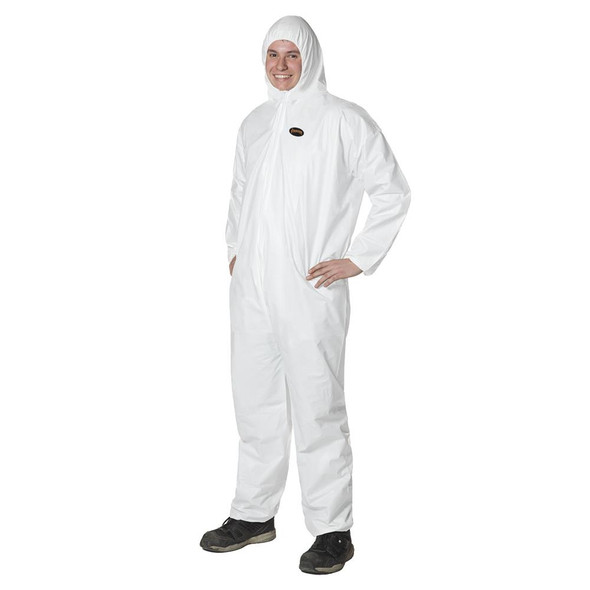
Antistatic Microporous Disposable Coveralls - Zipper Closure | Pioneer
Pioneer Workwear
$10.49Description Disposable coveralls that offer complete protection from front to back and top to bottom. Designed for comfort the elastic waist wrists and ankles promote freedom of movement and an improved hood and neck design reduces leakage points to...$10.49 -
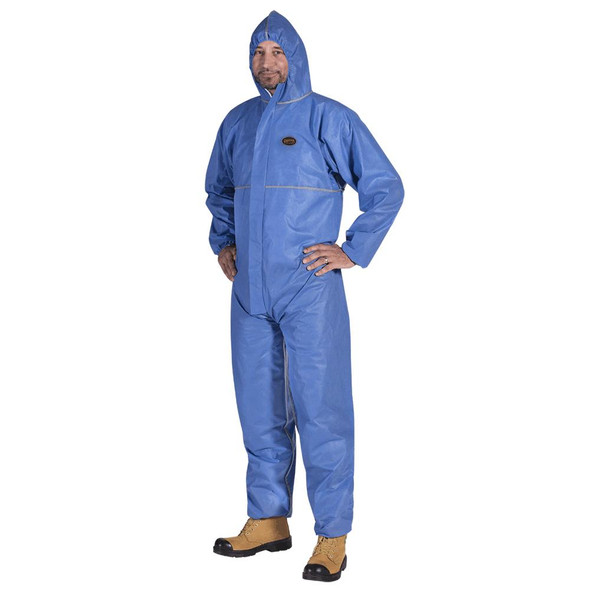
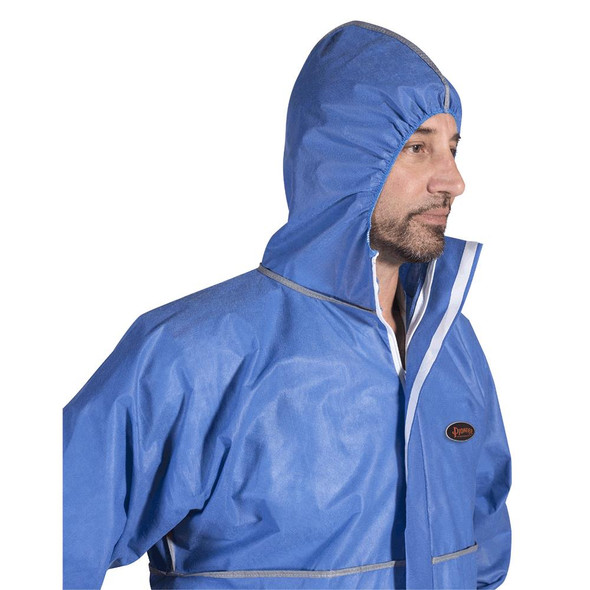
FSR SMS Disposable Coveralls – Zipper Closure | Pioneer
Pioneer Workwear
$8.51Description Disposable coveralls that offer complete protection from front to back and top to bottom. Designed for comfort the elastic waist wrists and ankles promote freedom of movement and an improved hood and neck design reduces leakage points to...$8.51 -


Women's Safety Poly/Cotton Coverall | Pioneer
Pioneer Workwear
$91.17Description These versatile and functional coveralls offer a high level of comfort and safety and are custom fit for hardworking women everywhere. Specially tailored with the woman worker in mind Poly/cotton material provides added comfort and is built...$91.17 -
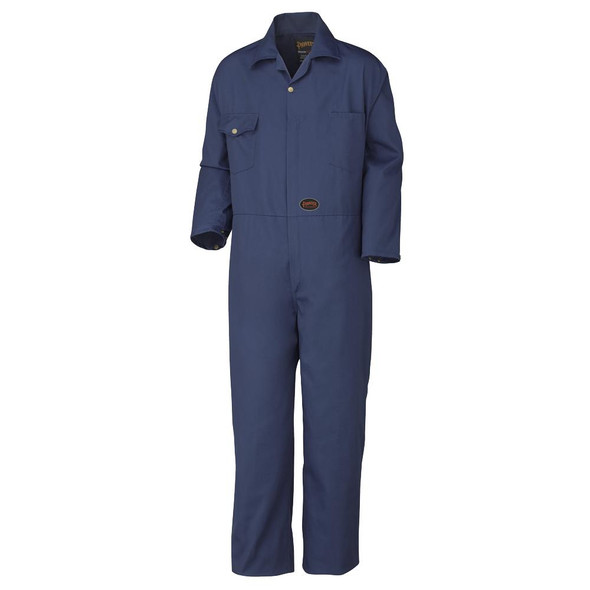
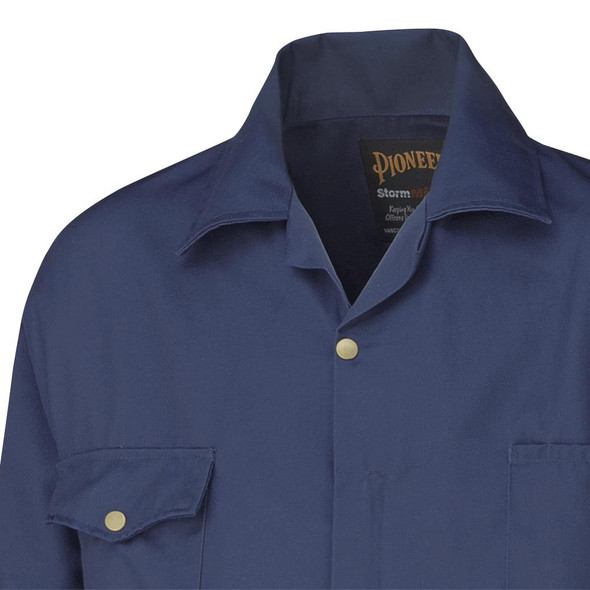
Poly/Cotton Coverall | Pioneer
Pioneer Workwear
$78.14Description Premium poly/cotton work coveralls providing full-length coverage for protection against grease oil and grime. Made with an action back and elastic waist for unsurpassed freedom of movement and wide range of motion. Made of comfortable and...$78.14 -
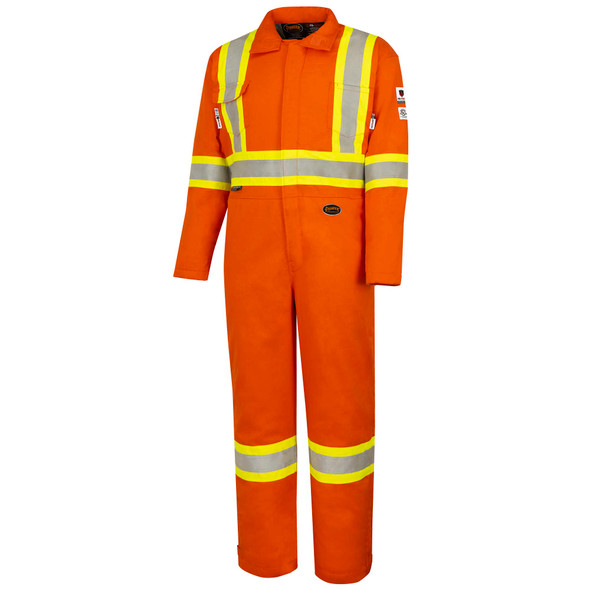

FR Quilted Safety Coverall | Pioneer
Pioneer Workwear
$537.01Description FR/Arc rated safety coveralls designed to keep you comfortable and safe while operating in potentially hazardous working conditions. Premium cotton and high-tenacity nylon blend provide an optimum blend of comfort and durability Modacrylic...$537.01 -
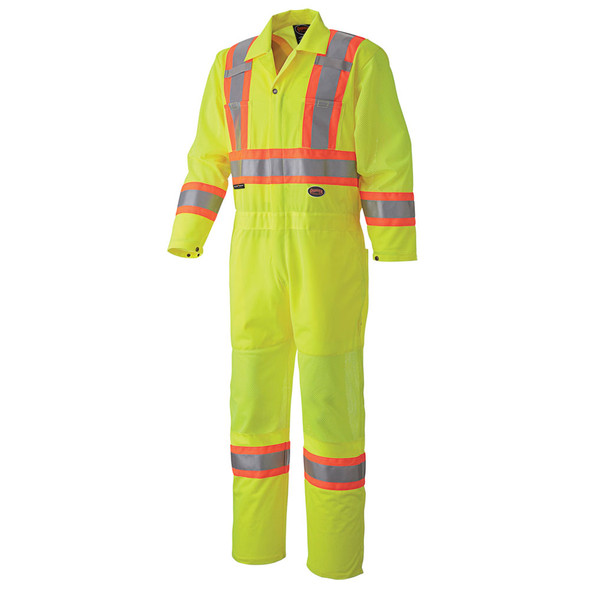

Hi-Vis Traffic Safety Coverall | Pioneer
Pioneer Workwear
$78.14Description These Hi-Vis traffic safety coveralls deliver a highly breathable garment with abrasion and tear resistance qualities and features moisture-wicking mesh ventilation panels on the upper arms and legs. Features moisture-wicking mesh...$78.14
